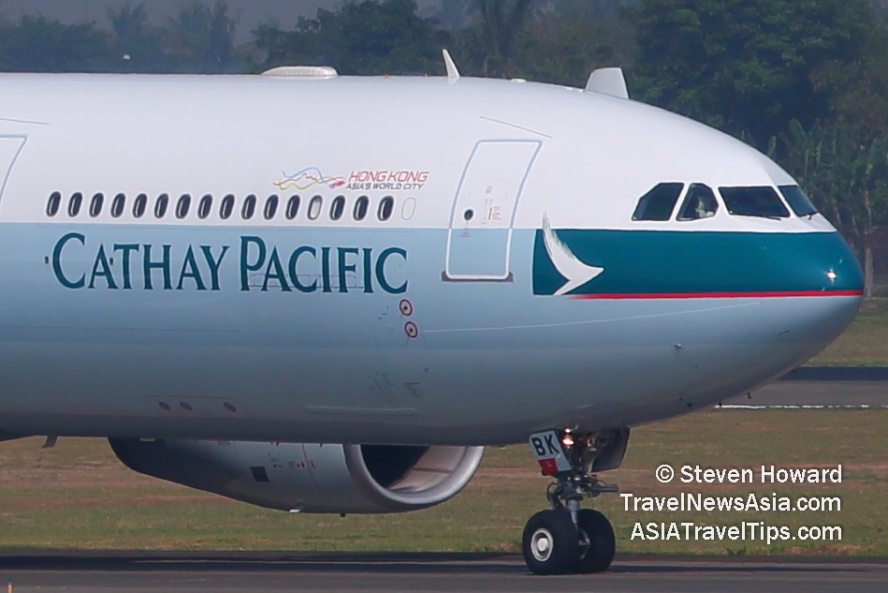|
(19 Nov 2021)
Cathay Pacific carried 76,430 passengers in
October, an increase of 98.3% compared to October 2020, but a
97.2% decrease when compared to the pre-pandemic level in October 2019.
The month�s revenue passenger kilometres (RPKs)
rose 95% year-on-year, down 96.1% versus October 2019, while the passenger load factor increased by 11.4 percentage points to
29.6%. Capacity, measured in available seat kilometres
(ASKs), increased by 19.9%, but remained 89.9% down on October
2019 levels.
In the first 10 months of 2021, the number of
passengers carried dropped by 87.8% against a 68.4% decrease in
capacity and an 84% decrease in RPKs, as compared to the same
period for 2020.

Cathay Pacific Airbus A330 reg: B-LBK. Picture by Steven Howard of TravelNewsAsia.com
Ronald Lam, Chief Customer and Commercial Officer,
said, �October was more challenging for our passenger business
than recent months. Demand for student travel, which had been
robust over the past few months, tapered down quickly from early
October. As such, we trimmed our passenger capacity by about 19%
compared to September.
�Overall, we only managed to operate
approximately 10% of our pre-pandemic passenger capacity compared
to October 2019. Meanwhile, our average daily passenger numbers
dropped about 44% versus the previous month to 2,465. While our
long-haul routes were less strong, our short-haul operations
remained robust with demand for flights serving Asia remaining
encouraging, in particular those serving the Philippines,
Indonesia and Vietnam.�
The airline carried 136,949 tonnes of cargo in
October 2021, an increase of 19.8% compared to the same month last
year, but a 25.2%
decrease compared with the same month in 2019.
October�s cargo
revenue tonne kilometres (RFTKs) rose 21% year-on-year,
down 14.9% compared to October 2019.
The cargo load factor
increased by 4 percentage points to 82.9%, while capacity,
measured in available cargo tonne kilometres (AFTKs), was up by
15.2% year-on-year, but down 30.3% versus October 2019.
In the
first 10 months of 2021, the tonnage decreased by 2.9% against a
14.7% drop in capacity and a 4.3% decrease in RFTKs, as compared
to the same period for 2020.
�Air cargo demand continued to strengthen in
October,� said Lam. �We maintained an optimised freighter schedule to meet
this demand, supplemented by capacity provided by our scheduled
passenger services. We also operated 963 pairs of cargo-only
passenger flights, including 78 sectors that were operated by our
converted �preighters� carrying cargo in the cabins � both
record-high numbers. Overall, we operated approximately 70% of our
pre-pandemic cargo capacity when compared to October 2019.
Meanwhile, our average load factor increased to nearly 83%. Our home market, Hong Kong, continued its strong
performance, and other markets around our network were similarly
encouraging. Southeast Asia in particular performed well with
robust exports of consumer products and industrial parts. Return
traffic from the Americas and Europe also gathered momentum.�
Looking Forward
�The second half of the year is typically our peak
cargo period,� Lam said. �The exceptionally strong cargo season that we are
experiencing so far, together with our continued focus on
effective cash and cost management, have led to a positive impact
on our operating cash burn. This is to the extent that we have
been able to achieve close to operating cash breakeven for the
four-month period from July to October 2021. On the passenger side, the re-opening of
Australia�s borders for vaccinated Australian citizens, permanent
residents and their immediate family has been a positive
development. We have already added more capacity and seen an
increase in flight bookings.�
|
Headlines: |
|
|
